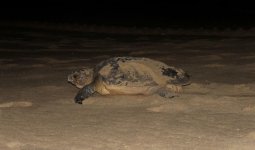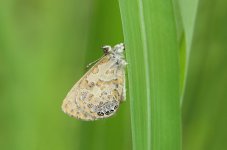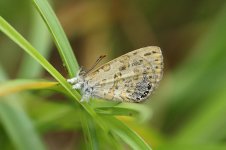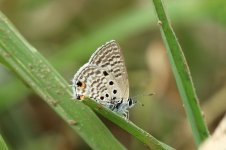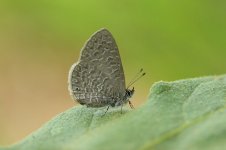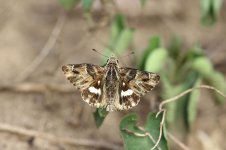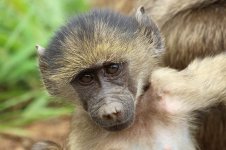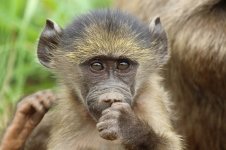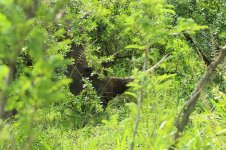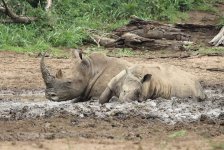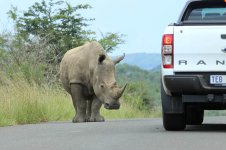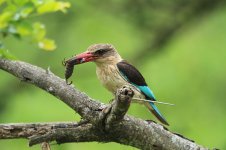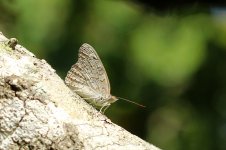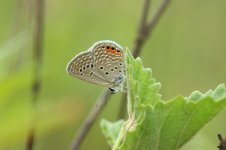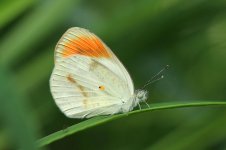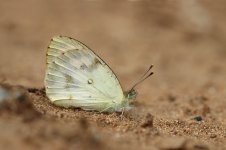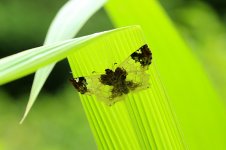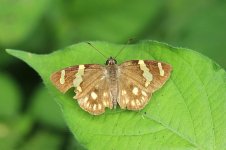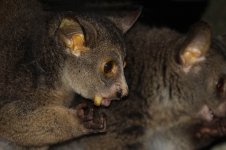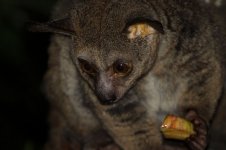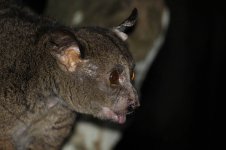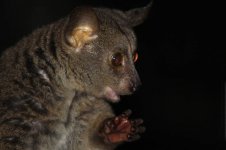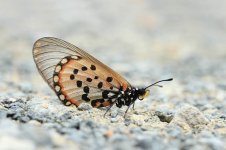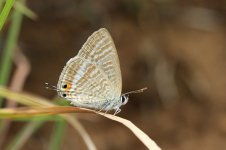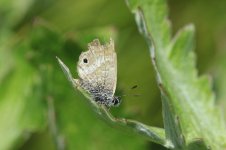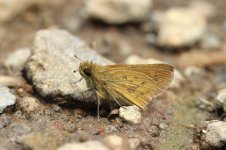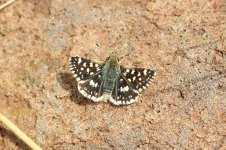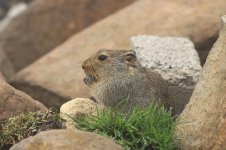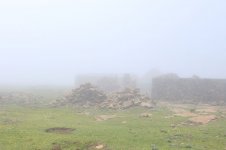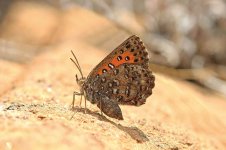
-
Welcome to BirdForum, the internet's largest birding community with thousands of members from all over the world. The forums are dedicated to wild birds, birding, binoculars and equipment and all that goes with it.
Please register for an account to take part in the discussions in the forum, post your pictures in the gallery and more.
You are using an out of date browser. It may not display this or other websites correctly.
You should upgrade or use an alternative browser.
You should upgrade or use an alternative browser.
Operation Lepidoptera, South Africa, 9-29 December 2017 (1 Viewer)
- Thread starter Jos Stratford
- Start date
More options
Who Replied?
19 December. False Bay.
Rain day, moved 120 km south to the False Bay section of Lake St Lucia and checked into Sand Forest Lodge, an excellent place with a good patch of habitat in the grounds, complete with trails. Rain did let up at around midday, but it remained damp and heavily overcast. Walked the grounds a couple of times and really felt it had great potential with no less than 11 species of butterflies noted despite the weather, this amounting to about 55 individuals. Smoky Orange Tips, African Common Whites and Sooty Blues the most common species, but Ashen Smoky Blue and Pale Ranger the most notable, both only recorded one other other time on the trip.
Less pleasing was the finding of a male Impala caught in an illegal snare, fortunately very much alive with the wire tight around the horns rather than neck. Alerted the lodge owner, collected wire cutters and returned to free the animal ...a feisty animal, was not quite so easy, but eventually the antelopes legs were grabbed and down it went while the wire was clipped. Off went one unharmed animal, a lucky individual. Systematic search of the area revealed another snare, both snares taken and destroyed.
Rain day, moved 120 km south to the False Bay section of Lake St Lucia and checked into Sand Forest Lodge, an excellent place with a good patch of habitat in the grounds, complete with trails. Rain did let up at around midday, but it remained damp and heavily overcast. Walked the grounds a couple of times and really felt it had great potential with no less than 11 species of butterflies noted despite the weather, this amounting to about 55 individuals. Smoky Orange Tips, African Common Whites and Sooty Blues the most common species, but Ashen Smoky Blue and Pale Ranger the most notable, both only recorded one other other time on the trip.
Less pleasing was the finding of a male Impala caught in an illegal snare, fortunately very much alive with the wire tight around the horns rather than neck. Alerted the lodge owner, collected wire cutters and returned to free the animal ...a feisty animal, was not quite so easy, but eventually the antelopes legs were grabbed and down it went while the wire was clipped. Off went one unharmed animal, a lucky individual. Systematic search of the area revealed another snare, both snares taken and destroyed.

20 December. False Bay.
Most productive butterfly day of the trip, good numbers overall and almost 50 species, largely due to the finding of an excellent locality in the afternoon.
Bright but overcast in the morning. Started out by checking roadside margins adjacent to False Bay Park - encouragingly, butterflies were already active by 8.00 a.m., this pointing to a good day ahead. On the wing, abundant Sulphur Orange Tips and Smoky Orange Tips, a medley of other common Pierids such as Brown-veined White, African Common White and African Veined White, plus less abundant species, including a half dozen very nice Vine-leaf Vagrants, a couple of Scarlet Tips, two Banded Gold Tips, two African Wood Whites and, the only ones identified on the trip, an Albatross White and a Common Grass Yellow. Plenty of non-Pierid action too - at least 30 Citrus Swallowtails, one Satyr Emperor vanishing over a canopy, an absolutely stunning Common Woolly Legs and, both representing my only sightings on the trip, a single Two-pip Policeman and a single Dusky Blue. Also saw Kersten's Hairtails and Black-striped Hairtails, assorted blues such as Topaz-spotted Blue and Thorntree Blue, plus quite a number of other common species.
False Bay Park itself, by contrast, was disappointing - not many butterflies and not that good for birds either, a few White Pelicans offshore and a couple of Woolly-necked Storks about the best of the bunch. Still rather overcast, so popped back to Sand Forest Lodge for a while, my bait traps here again not producing the masses of emperors that I had hoped, but at least attracting a couple of Squinting Bush Browns and, rather better, my first Evening Brown of the trip.
A change in the weather in the early afternoon, blue skies and a nice warm sun dominating. Purely on a speculative basis, I decided to check the northern side of Lake St Lucia, taking a small road to Nbele. And it was here that I was to encounter one of the most pleasing butterfly spectacles of the trip - on otherwise nondescript roadside edges, the last few hundred metres of acacia scrub before the entrance to Nbele Lake Lodge were abuzz with butterflies!
Sulphur Orange Tips, Smoky Orange Tips, Brown-veined Whites, African Common Whites and African Veined Whites all common as in many other localities, but here too quite a number of species that I recorded very rarely in other localities, these including at least 40 Scarlet Tips, 20 Veined Oranges, 20 Vine-leaf Vagrants, 10 Large Vagrants and eight Buquet's Vagrants, the latter also going by the very name name of Green-eyed Monster!
Lots of big colourful things drifting about too, not least a minimum of 20 Citrus Swallowtails, plus a Green-banded Swallowtail, my only Constantine's Swallowtail of the trip, four Small Striped Swordtails and my only two Mamba Swordtails of the trip, stunning butterflies all. Truly was a pleasure to slowly amble along this roadside, sifting through the masses of butterflies to discover species after species of new butterfly. Amongst the many additional species, eight Novices, a Club-tailed Emperor, one Gaika Blue (only two on the whole trip) and both African Snout-nosed Butterfly and Green-marbled Sandman (both not recorded elsewhere). Also managed to identify at least one Coastal Hairstreak flying with Purple-brown Hairstreaks.
Back at Sand Forest Lodge, as dusk approached, one more Evening Brown to round the day off.
Most productive butterfly day of the trip, good numbers overall and almost 50 species, largely due to the finding of an excellent locality in the afternoon.
Bright but overcast in the morning. Started out by checking roadside margins adjacent to False Bay Park - encouragingly, butterflies were already active by 8.00 a.m., this pointing to a good day ahead. On the wing, abundant Sulphur Orange Tips and Smoky Orange Tips, a medley of other common Pierids such as Brown-veined White, African Common White and African Veined White, plus less abundant species, including a half dozen very nice Vine-leaf Vagrants, a couple of Scarlet Tips, two Banded Gold Tips, two African Wood Whites and, the only ones identified on the trip, an Albatross White and a Common Grass Yellow. Plenty of non-Pierid action too - at least 30 Citrus Swallowtails, one Satyr Emperor vanishing over a canopy, an absolutely stunning Common Woolly Legs and, both representing my only sightings on the trip, a single Two-pip Policeman and a single Dusky Blue. Also saw Kersten's Hairtails and Black-striped Hairtails, assorted blues such as Topaz-spotted Blue and Thorntree Blue, plus quite a number of other common species.
False Bay Park itself, by contrast, was disappointing - not many butterflies and not that good for birds either, a few White Pelicans offshore and a couple of Woolly-necked Storks about the best of the bunch. Still rather overcast, so popped back to Sand Forest Lodge for a while, my bait traps here again not producing the masses of emperors that I had hoped, but at least attracting a couple of Squinting Bush Browns and, rather better, my first Evening Brown of the trip.
A change in the weather in the early afternoon, blue skies and a nice warm sun dominating. Purely on a speculative basis, I decided to check the northern side of Lake St Lucia, taking a small road to Nbele. And it was here that I was to encounter one of the most pleasing butterfly spectacles of the trip - on otherwise nondescript roadside edges, the last few hundred metres of acacia scrub before the entrance to Nbele Lake Lodge were abuzz with butterflies!
Sulphur Orange Tips, Smoky Orange Tips, Brown-veined Whites, African Common Whites and African Veined Whites all common as in many other localities, but here too quite a number of species that I recorded very rarely in other localities, these including at least 40 Scarlet Tips, 20 Veined Oranges, 20 Vine-leaf Vagrants, 10 Large Vagrants and eight Buquet's Vagrants, the latter also going by the very name name of Green-eyed Monster!
Lots of big colourful things drifting about too, not least a minimum of 20 Citrus Swallowtails, plus a Green-banded Swallowtail, my only Constantine's Swallowtail of the trip, four Small Striped Swordtails and my only two Mamba Swordtails of the trip, stunning butterflies all. Truly was a pleasure to slowly amble along this roadside, sifting through the masses of butterflies to discover species after species of new butterfly. Amongst the many additional species, eight Novices, a Club-tailed Emperor, one Gaika Blue (only two on the whole trip) and both African Snout-nosed Butterfly and Green-marbled Sandman (both not recorded elsewhere). Also managed to identify at least one Coastal Hairstreak flying with Purple-brown Hairstreaks.
Back at Sand Forest Lodge, as dusk approached, one more Evening Brown to round the day off.

Small ones from the day, including the brilliant Woolly Legs ...
Attachments
Last edited:

21 December. Hluluwe & St Lucia.
Decided for a slight chance of focus this day - instead of heading directly to St Lucia and my next butterfly sites, veered slightly to the west to add the Hluhluwe Game Reserve to my route. A massive chunk of hill country, a sizeable number of White Rhino inhabit this area, plus Lions, Wild Dogs, etc.
Entering from the north, we almost immediately ran into a sizeable herd of Buffalo, perhaps 80 strong, then a large troop of Baboons. With hordes of wide-eyed youngsters, I thought these Baboons were quite engaging, all very busy in a mass grooming sessions ...Little One was inclined to disagree, still considering them her enemy number one!
A little further, and certainly more intriguing, was the appearance of a Brown-hooded Kingfisher on a dead snag aside the tree. Nice enough in itself, but the intrigue was how it planned to deal with the Thin-tailed Scorpion it had caught. Brute force was the answer, the scorpion trying in vein to sting the kingfisher with the tail sting lashing at the bird's bill, but almost immediately the scorpion was being repeatedly smashed against the branch. Game over, soon the scorpion was becoming at ex-scorpion and soon to be tasty morsel! Overhead, Cape Vulture and White-backed Vulture added to the entertainment, while two Small Buttonquail scuttling across the road shortly after were also welcome.
It was however getting quite hot and sunny in Hluluwe and overall numbers were not that amazing on this visit, so thoughts began to turn to St Lucia, maybe time to head out. However, some nice parting shots as we began to trundle towards an exit - first a single White Rhino in think bush next to the track, then two more in a mudhole, then a mother and calf at a small pool and then yet another crossing the road! Six White Rhinos in half an hour, not bad. And with that, we departed and headed for the coast.
Half an hour later I was in the pleasant town of St Lucia and even more pleasant apartment that we had rented for the next two nights. From a butterfly angle however, day one at St Lucia was remarkably poor – headed to areas north of town, but as with a couple of earlier localities, it was exceptionally dry with basically no greenery or flowers and few butterflies. On top of this, though sunny, it was exceptionally windy! This said, although numbers were mostly low, I did manage 18 species – hedgerows along the edge of town attracted three Common Wanderers, a few Natal Acraeas, a Forest Leopard and both Purple-brown Hairstreak and Southern Pied Woolly Legs, while open country offered Sulphur Orange Tips and Smoky Orange Tips, as well as Grass Jewel Blues, three Angled Grass Yellows and my only Spiller's Sulphur Yellow of the trip. Also saw a number of African Monarchs, at least 10 Black-striped Hairtails and four Kersten's Hairtails. On the bird front, best of the day was a Black Coucal.
Highlight of the day though came with the discovery of a colony of about Natal Tree Nymphs. A new species for me, these would seem to patrol their territory every now and then, before returning to a favoured resting point on a branch. In the general area.
Decided for a slight chance of focus this day - instead of heading directly to St Lucia and my next butterfly sites, veered slightly to the west to add the Hluhluwe Game Reserve to my route. A massive chunk of hill country, a sizeable number of White Rhino inhabit this area, plus Lions, Wild Dogs, etc.
Entering from the north, we almost immediately ran into a sizeable herd of Buffalo, perhaps 80 strong, then a large troop of Baboons. With hordes of wide-eyed youngsters, I thought these Baboons were quite engaging, all very busy in a mass grooming sessions ...Little One was inclined to disagree, still considering them her enemy number one!
A little further, and certainly more intriguing, was the appearance of a Brown-hooded Kingfisher on a dead snag aside the tree. Nice enough in itself, but the intrigue was how it planned to deal with the Thin-tailed Scorpion it had caught. Brute force was the answer, the scorpion trying in vein to sting the kingfisher with the tail sting lashing at the bird's bill, but almost immediately the scorpion was being repeatedly smashed against the branch. Game over, soon the scorpion was becoming at ex-scorpion and soon to be tasty morsel! Overhead, Cape Vulture and White-backed Vulture added to the entertainment, while two Small Buttonquail scuttling across the road shortly after were also welcome.
It was however getting quite hot and sunny in Hluluwe and overall numbers were not that amazing on this visit, so thoughts began to turn to St Lucia, maybe time to head out. However, some nice parting shots as we began to trundle towards an exit - first a single White Rhino in think bush next to the track, then two more in a mudhole, then a mother and calf at a small pool and then yet another crossing the road! Six White Rhinos in half an hour, not bad. And with that, we departed and headed for the coast.
Half an hour later I was in the pleasant town of St Lucia and even more pleasant apartment that we had rented for the next two nights. From a butterfly angle however, day one at St Lucia was remarkably poor – headed to areas north of town, but as with a couple of earlier localities, it was exceptionally dry with basically no greenery or flowers and few butterflies. On top of this, though sunny, it was exceptionally windy! This said, although numbers were mostly low, I did manage 18 species – hedgerows along the edge of town attracted three Common Wanderers, a few Natal Acraeas, a Forest Leopard and both Purple-brown Hairstreak and Southern Pied Woolly Legs, while open country offered Sulphur Orange Tips and Smoky Orange Tips, as well as Grass Jewel Blues, three Angled Grass Yellows and my only Spiller's Sulphur Yellow of the trip. Also saw a number of African Monarchs, at least 10 Black-striped Hairtails and four Kersten's Hairtails. On the bird front, best of the day was a Black Coucal.
Highlight of the day though came with the discovery of a colony of about Natal Tree Nymphs. A new species for me, these would seem to patrol their territory every now and then, before returning to a favoured resting point on a branch. In the general area.





22 December. St Lucia.
Having been largely underwhelmed by the butterfly selection around St Lucia the day before, I did not have big expectations this day, even less so as it was overcast again! Basic plan for the day was to give the Igwalagwala Trail a quick walk, then perhaps leave town. The Igwalagwala Trail, cutting through luxuriant forest, is primarily known to birders for Woodward's Batis, so to the site I went fairly early, hoping at least to see the batis. I was to be impressed, not only did I see the desired Woodward's Batis and a number of other birds such as Trumpeter Hornbills, Crowned Hornbills, Red-capped Robin-Chats and Tambourine Doves, but it also turned out to be excellent for butterflies, including one small species that immediately became a contender for the title 'butterfly of the trip'.
Even from early morning, abundant 'drifters' floated around open patches of forest, but this being the Amauris group and its associated mimics, the actual species yet again caused me quite some confusion -in quite some part due to their reluctance to settle and tendency to fly at about twice head height! Attractive butterflies though, I think a fairly accurate estimate of the relative numbers that I saw would be at least 40 Novices, at least 15 Friars and two of the larger Laymen. Also big and bold, one Mocker Swallowtail, one Green-banded Swallowtail, four Small Striped Swordtails and, my only ones on the trip, two Veined Swordtails.
Lots more nice stuff too, not least a Fiery Acraea and a White-barred Acraea, as well as several Natal Acraeas, along with three Golden Pipers and, subject to possible identification error, one Forest Leopard. Really was a pleasure ambling around the maze of tracks, new butterflies at every turn - amongst the big, the bright and the wonderful, quite a number of interesting Pierids, including my only False Dotted Borders of the trip, plus Vine-leaf Vagrant, Cambridge Vagrant, Diverse White and Angled Grass Yellow, while non-Pierids included one Southern Pied Woolly Legs and two Purple-brown Hairstreaks, plus plenty of Kersten's Hairtails, at least six Pale Hairtails and a couple of the more distinct Black-striped Hairtails. Top Lycaenidae of the day however was a single Babault's Blue, a slightly problematic species to identify and one of only two recorded on the whole trip.
Far and above all other species though, and the contender for butterfly of the trip, was a little butterfly quietly roosting in the underside of a leaf - partially translucent, variously described as a bird dropping on a leaf, and a species I was very much hoping to find, the price was a splendid Buff-tipped Skipper. Very pleased indeed I was with this one! Also very welcome, especially given the date, a Christmas Forester and, a short while later, its cousin a Clouded Forester.
Could easily have stayed in the forest the whole day, but from about 3 p.m. the skies darkened considerably - the sun had not come out at all during the day, but now it was looking more and more ominous. An hour later, the rain began and it absolutely bucketed it down for the remainder of the day. Final sighting of the day, twelve soggy Banded Mongooses dashing across the lawn behind our apartment.
Having been largely underwhelmed by the butterfly selection around St Lucia the day before, I did not have big expectations this day, even less so as it was overcast again! Basic plan for the day was to give the Igwalagwala Trail a quick walk, then perhaps leave town. The Igwalagwala Trail, cutting through luxuriant forest, is primarily known to birders for Woodward's Batis, so to the site I went fairly early, hoping at least to see the batis. I was to be impressed, not only did I see the desired Woodward's Batis and a number of other birds such as Trumpeter Hornbills, Crowned Hornbills, Red-capped Robin-Chats and Tambourine Doves, but it also turned out to be excellent for butterflies, including one small species that immediately became a contender for the title 'butterfly of the trip'.
Even from early morning, abundant 'drifters' floated around open patches of forest, but this being the Amauris group and its associated mimics, the actual species yet again caused me quite some confusion -in quite some part due to their reluctance to settle and tendency to fly at about twice head height! Attractive butterflies though, I think a fairly accurate estimate of the relative numbers that I saw would be at least 40 Novices, at least 15 Friars and two of the larger Laymen. Also big and bold, one Mocker Swallowtail, one Green-banded Swallowtail, four Small Striped Swordtails and, my only ones on the trip, two Veined Swordtails.
Lots more nice stuff too, not least a Fiery Acraea and a White-barred Acraea, as well as several Natal Acraeas, along with three Golden Pipers and, subject to possible identification error, one Forest Leopard. Really was a pleasure ambling around the maze of tracks, new butterflies at every turn - amongst the big, the bright and the wonderful, quite a number of interesting Pierids, including my only False Dotted Borders of the trip, plus Vine-leaf Vagrant, Cambridge Vagrant, Diverse White and Angled Grass Yellow, while non-Pierids included one Southern Pied Woolly Legs and two Purple-brown Hairstreaks, plus plenty of Kersten's Hairtails, at least six Pale Hairtails and a couple of the more distinct Black-striped Hairtails. Top Lycaenidae of the day however was a single Babault's Blue, a slightly problematic species to identify and one of only two recorded on the whole trip.
Far and above all other species though, and the contender for butterfly of the trip, was a little butterfly quietly roosting in the underside of a leaf - partially translucent, variously described as a bird dropping on a leaf, and a species I was very much hoping to find, the price was a splendid Buff-tipped Skipper. Very pleased indeed I was with this one! Also very welcome, especially given the date, a Christmas Forester and, a short while later, its cousin a Clouded Forester.
Could easily have stayed in the forest the whole day, but from about 3 p.m. the skies darkened considerably - the sun had not come out at all during the day, but now it was looking more and more ominous. An hour later, the rain began and it absolutely bucketed it down for the remainder of the day. Final sighting of the day, twelve soggy Banded Mongooses dashing across the lawn behind our apartment.


23 December. Mtunzini.
In beautiful bright sunny conditions, shifted another 110 km south to the Mtunzini area, largely to have a nice base for the Christmas period and to day trip Dlinza Forest in the interior. First stop near Mtunzini was the Raffia Palm Forest - have never seen vert much at this locality, and didn't buck the trend today! An hour or so wandering not revealing the Palm-nut Vultures that inhabit the area and also not producing much in the way of butterflies - the main exception being an unfortunate Giant Emperor that was being attacked by a mass of ants! A new species for me, I thought this stunning species deserved a second chance and I tried to save it, brushing off the swarms of ants ...I do fear however it was probably too late.
In Mtunzini itself, checked into the rather upmarket Mtunzini Forest Lodge, accommodation being a very nice wooden cabin set in luxuriant forest, a buzz of butterflies on the trails around and a very nice deserted beach just a short stroll away. Plenty of good butterflies here - Green-banded Swallowtail, Mocker Swallowtail, Citrus Swallowtail and Common Leopard, also a White-barred Acraea (as well as more common Natal Acraea), at least six Golden Pipers and one Friar. Caught a Squinting Bush Brown in my bait trap, while assorted Peirids included abundant African Common Whites, along with a single Diverse White, an African Wood White and a Broad-bordered Grass Yellow.
Still having a desire to see Palm-nut Vulture, popped out to the small forest strips just west of town – and was soon rewarded with a fine adult Palm-nut Vulture sharing a thermal with a couple of Woolly-necked Storks, Not only Palm-nut Vulture here, but a pleasing selection of butterflies too, including two new species for me - Rusty Swift and Olive-haired Swift – and an impressive colony of mixed woolly legs, a single shrub attracting at least 15 Southern Pied Woolly Legs and Common Woolly Legs, many attending ants. Also here, four Brown Pansies, a single Blue Pansy, a Babault's Blue, about ten Sooty Blues and a couple of Grass Jewel Blues.
Easy evening around Mtunzini Forest Lodge, a number of mammals including Water Mongoose, four Red Duikers and many Vervet Monkeys.
24 December. Dlinza Forest.
Sub-tropical forest, 25 C and sun, Christmas approaching! The only elements missing to a perfect Christmas at Dlinza Forest were the hordes of butterflies that I had expected! For locality that should have held abundant emperors and other species, I can only assume I was a little early in the season.
As it was, I managed a mere 12 species and a couple of these only in adjacent meadows. From an aerial walkway that offers splendid views across the canopy, not a single emperor did I see, nor very much else for that matter. A few Amarius butterflies were flying around, landing on occasion, all Common Leopards I think, though I am not confident of my identification and I can not exclude Forest Leopards. Also from the aerial walkway, though never landing close enough for good photographs, were my first new butterflies of the day – my ninth Acraea of the trip, a pair of the very appropriately named Tree-top Acraeas! Three Mocker Swallowtails up here too.
Down below, in the dark of the forest, even fewer butterflies! Quite a lot of walking for not very many butterflies was the order of the day - in dappled patches of sunlight, a few Common Bush Browns and a couple of Squinting Bush Browns, while a broad relatively sunny track did provide a little more variety in the form of three Southern Pied Woolly Legs, four Twin Dotted Borders, one Angled Grass Yellow, three Sooty Blues and, the only one recorded on the trip, an Orange Spotted Hopper.
Wandered round for most of the morning, even tried an area of meadow nearby with little extra success (one Blue Pansy, several African Common Whites and and a few African Migrants), then decided it was time to call it quits, a mere dozen species under my belt. Headed to the local town, did a bit of Christmas shopping, not very peasant, and then returned to Mtunzini fairly early.
Relaxing late afternoon, two Giant Emperors near our cabin, plus two Golden Pipers, one Vine-leaf Vagrant, a Common Hairtail and my only False Chiefs of the trip and only Coast Purple Tip. Wandered as far as the beach for a few moments, then began to prepare for nightfall – treats for Santa set upon the table, plus a great pile of chopped apples on a small feeding platform in a tree near the Mtunzini Camp restaurant. And there we sat as it got totally dark, a wait then of only 15 minutes or so before some rustling in the trees. Flicked on a flashlight to see that the guests had arrived, four quite amazing Greater Bushbabies, one already stuffing its face with the fruit, three more clambering down the tree to join him. And fabulous it was, the four feeding for the next 20 minutes unabated, occasionally retreating to higher branches if they thought they heard something, though quickly returning. As appetites were satisfied, lips licked and I like to think a content smile upon their faces, they clambered back up the trees and vanished into the darkness. A wonderful experience indeed.
Walked back to the cabin only to find two more Greater Bushbabies there two, chopped a last apple or two and left it for them, though to bed it was for me.
In beautiful bright sunny conditions, shifted another 110 km south to the Mtunzini area, largely to have a nice base for the Christmas period and to day trip Dlinza Forest in the interior. First stop near Mtunzini was the Raffia Palm Forest - have never seen vert much at this locality, and didn't buck the trend today! An hour or so wandering not revealing the Palm-nut Vultures that inhabit the area and also not producing much in the way of butterflies - the main exception being an unfortunate Giant Emperor that was being attacked by a mass of ants! A new species for me, I thought this stunning species deserved a second chance and I tried to save it, brushing off the swarms of ants ...I do fear however it was probably too late.
In Mtunzini itself, checked into the rather upmarket Mtunzini Forest Lodge, accommodation being a very nice wooden cabin set in luxuriant forest, a buzz of butterflies on the trails around and a very nice deserted beach just a short stroll away. Plenty of good butterflies here - Green-banded Swallowtail, Mocker Swallowtail, Citrus Swallowtail and Common Leopard, also a White-barred Acraea (as well as more common Natal Acraea), at least six Golden Pipers and one Friar. Caught a Squinting Bush Brown in my bait trap, while assorted Peirids included abundant African Common Whites, along with a single Diverse White, an African Wood White and a Broad-bordered Grass Yellow.
Still having a desire to see Palm-nut Vulture, popped out to the small forest strips just west of town – and was soon rewarded with a fine adult Palm-nut Vulture sharing a thermal with a couple of Woolly-necked Storks, Not only Palm-nut Vulture here, but a pleasing selection of butterflies too, including two new species for me - Rusty Swift and Olive-haired Swift – and an impressive colony of mixed woolly legs, a single shrub attracting at least 15 Southern Pied Woolly Legs and Common Woolly Legs, many attending ants. Also here, four Brown Pansies, a single Blue Pansy, a Babault's Blue, about ten Sooty Blues and a couple of Grass Jewel Blues.
Easy evening around Mtunzini Forest Lodge, a number of mammals including Water Mongoose, four Red Duikers and many Vervet Monkeys.
24 December. Dlinza Forest.
Sub-tropical forest, 25 C and sun, Christmas approaching! The only elements missing to a perfect Christmas at Dlinza Forest were the hordes of butterflies that I had expected! For locality that should have held abundant emperors and other species, I can only assume I was a little early in the season.
As it was, I managed a mere 12 species and a couple of these only in adjacent meadows. From an aerial walkway that offers splendid views across the canopy, not a single emperor did I see, nor very much else for that matter. A few Amarius butterflies were flying around, landing on occasion, all Common Leopards I think, though I am not confident of my identification and I can not exclude Forest Leopards. Also from the aerial walkway, though never landing close enough for good photographs, were my first new butterflies of the day – my ninth Acraea of the trip, a pair of the very appropriately named Tree-top Acraeas! Three Mocker Swallowtails up here too.
Down below, in the dark of the forest, even fewer butterflies! Quite a lot of walking for not very many butterflies was the order of the day - in dappled patches of sunlight, a few Common Bush Browns and a couple of Squinting Bush Browns, while a broad relatively sunny track did provide a little more variety in the form of three Southern Pied Woolly Legs, four Twin Dotted Borders, one Angled Grass Yellow, three Sooty Blues and, the only one recorded on the trip, an Orange Spotted Hopper.
Wandered round for most of the morning, even tried an area of meadow nearby with little extra success (one Blue Pansy, several African Common Whites and and a few African Migrants), then decided it was time to call it quits, a mere dozen species under my belt. Headed to the local town, did a bit of Christmas shopping, not very peasant, and then returned to Mtunzini fairly early.
Relaxing late afternoon, two Giant Emperors near our cabin, plus two Golden Pipers, one Vine-leaf Vagrant, a Common Hairtail and my only False Chiefs of the trip and only Coast Purple Tip. Wandered as far as the beach for a few moments, then began to prepare for nightfall – treats for Santa set upon the table, plus a great pile of chopped apples on a small feeding platform in a tree near the Mtunzini Camp restaurant. And there we sat as it got totally dark, a wait then of only 15 minutes or so before some rustling in the trees. Flicked on a flashlight to see that the guests had arrived, four quite amazing Greater Bushbabies, one already stuffing its face with the fruit, three more clambering down the tree to join him. And fabulous it was, the four feeding for the next 20 minutes unabated, occasionally retreating to higher branches if they thought they heard something, though quickly returning. As appetites were satisfied, lips licked and I like to think a content smile upon their faces, they clambered back up the trees and vanished into the darkness. A wonderful experience indeed.
Walked back to the cabin only to find two more Greater Bushbabies there two, chopped a last apple or two and left it for them, though to bed it was for me.


Been off travelling, so apologies for delay in finishing this thread!
25 December. Sani Pass.
After bunches of Vervet Monkeys invading the chalet early morning, polishing off the fruit left for the Greater Bushbabies, it was time to leave Mtunzini for the four-hour drive to the Drakensburg highlands.
Upon the horizon, the dramatic settings of Sani Pass appeared early afternoon, all the more pleasing that the towering cliffs were bathed in sun. Wasting no time, we navigated the rough track that zigzags up to the South African border post and left the car (only 4x4s permitted past this point), an adjacent bush attracting quite a number of Garden Acraea. Commonplace Cape Robin-Chats and Dark-capped Bulbuls, Cape Vulture and Jackal Buzzard overhead.
Continued upward on foot towards Lesotho, a trio of Ground Woodpeckers hopping about on boulders, a Barratt's Warbler in streamside vegetation, a Buff-streaked Chat in open country, also Malachite and Greater Double-collared Sunbirds, a few Cape Grassbirds and several Karoo Prinias.
Butterflies however were relatively few and far between – highly mobile skippers kept flitting around, those eventually tracked down morphing into several Common Hottentot Skippers, three Mafa Sandmen and a single Unique Ranger. Also added a tatty Marsh Blue, my first Long-tailed Blue of the trip and two rather stunning Water Bronzes. Also at least five Common Hairtails, a couple of Yellow Pansies and two African Monarchs. Unfortunately, after just a couple of hours, ominous clouds began to blot the otherwise blue sky and not long after it was a picture of grey and temperatures plummeted somewhat, pretty much crushing hopes of any further butterflies.
Walked down to the car and bumped back down the track to Sani Backpackers, home for the next two nights. Cloud and mist for the remainder of the day, walks adding no more butterflies. Though I had managed a total of just ten species during the day, half of these were new for the trip. Plans to climb to Lesotho next day, the high grasslands there hopefully adding a few speciality butterflies.
26 December. Sani Pass.
Heavy rain through the night, low cloud and drizzle at dawn, cold. A slight brightening at 9.00 a.m. hinted at things might improve, returned to the South African border post and began the long hike up to Lesotho. Clouds rolling in, the brightness vanished, found Ground Woodpeckers again, plus one Black Bushcap and several Southern Boubous. Appearing through the mist, a flock of 33 White Storks heading into the valley, circling round, then dropping onto the slopes. Found two butterfly species only, both roosting – one Long-tailed Blue and a couple of Garden Acraea.
Thinking Lesotho itself, the top of the pass at near 2900 metres, might be above the cloud, we decided to hitch a lift with a passing bukkie. Bounced about quite a bit as the track deteriorated in the steep upper sections, several Rock Hyrax seen in this section. Then we got to the Lesotho border post – cloud-bound, thick swirls of mist rolling over the lip of the plateau, visibility a hundred metres at best, more often a mere 10-20 metres! A fascinating area nonetheless, but needless to say saw almost nothing - one Sentinel Rock Thrush on some rock huts, four White-naped Ravens at the edge of the cliffs. After a short stroll, getting considerably chilled in the process, wandered over to Sani Top, Africa's highest pub, one that on a good day offers the possibility of eye-to-eye Lammergeiers and other raptors from their veranda. No chance of any of those on this foggy day, couldn't even find the pub to begin with! In between toasted sandwiches and coffee, did pop out a few times to endure the cold mist – added four Drakensburg Siskins and photographed one Sloggart's Ice Rat.
And with that, decided to head back down. Quickly hitched a lift in another bukkie and a half hour or so later was back at considerably lower altitude, beneath the cloud. Walked along a stream area, Cape Grassbirds and Dark-capped Yellow Warbler the main birds seen, then retrieved the car and continued down the valley. Stopped at a patch of proteas and finally found the bird I had been looking for, Gurney's Sugarbird - a pair of these iconic birds feeding at close quarters, then another pair at more proteas a few hundred metres further.
Returned to Sani Backpackers about 4 p.m., one Baboon wandering down the road just nearby, decided to call it a day.
25 December. Sani Pass.
After bunches of Vervet Monkeys invading the chalet early morning, polishing off the fruit left for the Greater Bushbabies, it was time to leave Mtunzini for the four-hour drive to the Drakensburg highlands.
Upon the horizon, the dramatic settings of Sani Pass appeared early afternoon, all the more pleasing that the towering cliffs were bathed in sun. Wasting no time, we navigated the rough track that zigzags up to the South African border post and left the car (only 4x4s permitted past this point), an adjacent bush attracting quite a number of Garden Acraea. Commonplace Cape Robin-Chats and Dark-capped Bulbuls, Cape Vulture and Jackal Buzzard overhead.
Continued upward on foot towards Lesotho, a trio of Ground Woodpeckers hopping about on boulders, a Barratt's Warbler in streamside vegetation, a Buff-streaked Chat in open country, also Malachite and Greater Double-collared Sunbirds, a few Cape Grassbirds and several Karoo Prinias.
Butterflies however were relatively few and far between – highly mobile skippers kept flitting around, those eventually tracked down morphing into several Common Hottentot Skippers, three Mafa Sandmen and a single Unique Ranger. Also added a tatty Marsh Blue, my first Long-tailed Blue of the trip and two rather stunning Water Bronzes. Also at least five Common Hairtails, a couple of Yellow Pansies and two African Monarchs. Unfortunately, after just a couple of hours, ominous clouds began to blot the otherwise blue sky and not long after it was a picture of grey and temperatures plummeted somewhat, pretty much crushing hopes of any further butterflies.
Walked down to the car and bumped back down the track to Sani Backpackers, home for the next two nights. Cloud and mist for the remainder of the day, walks adding no more butterflies. Though I had managed a total of just ten species during the day, half of these were new for the trip. Plans to climb to Lesotho next day, the high grasslands there hopefully adding a few speciality butterflies.
26 December. Sani Pass.
Heavy rain through the night, low cloud and drizzle at dawn, cold. A slight brightening at 9.00 a.m. hinted at things might improve, returned to the South African border post and began the long hike up to Lesotho. Clouds rolling in, the brightness vanished, found Ground Woodpeckers again, plus one Black Bushcap and several Southern Boubous. Appearing through the mist, a flock of 33 White Storks heading into the valley, circling round, then dropping onto the slopes. Found two butterfly species only, both roosting – one Long-tailed Blue and a couple of Garden Acraea.
Thinking Lesotho itself, the top of the pass at near 2900 metres, might be above the cloud, we decided to hitch a lift with a passing bukkie. Bounced about quite a bit as the track deteriorated in the steep upper sections, several Rock Hyrax seen in this section. Then we got to the Lesotho border post – cloud-bound, thick swirls of mist rolling over the lip of the plateau, visibility a hundred metres at best, more often a mere 10-20 metres! A fascinating area nonetheless, but needless to say saw almost nothing - one Sentinel Rock Thrush on some rock huts, four White-naped Ravens at the edge of the cliffs. After a short stroll, getting considerably chilled in the process, wandered over to Sani Top, Africa's highest pub, one that on a good day offers the possibility of eye-to-eye Lammergeiers and other raptors from their veranda. No chance of any of those on this foggy day, couldn't even find the pub to begin with! In between toasted sandwiches and coffee, did pop out a few times to endure the cold mist – added four Drakensburg Siskins and photographed one Sloggart's Ice Rat.
And with that, decided to head back down. Quickly hitched a lift in another bukkie and a half hour or so later was back at considerably lower altitude, beneath the cloud. Walked along a stream area, Cape Grassbirds and Dark-capped Yellow Warbler the main birds seen, then retrieved the car and continued down the valley. Stopped at a patch of proteas and finally found the bird I had been looking for, Gurney's Sugarbird - a pair of these iconic birds feeding at close quarters, then another pair at more proteas a few hundred metres further.
Returned to Sani Backpackers about 4 p.m., one Baboon wandering down the road just nearby, decided to call it a day.
Last edited:



27 December. Golden Gate Highlands National Park.
Leaving Sani quite early, it was pleasing to see blue skies on the northern horizon, the approximate direction we were heading and in not too long at all, we were indeed in full sunshine. A random stop at a patch of blackberries proved productive – blackberries for breakfast and a Gold-spotted Sylph as an expected bonus, an attractive skipper species and the only one that I would see on this trip.
Travelling further, as flocks of Amur Falcon adorned roadside wires and White Storks populated agricultural field, the high crags of the Golden Gate National Park appeared on the horizon, destination for this day.
The edge of the Drakensburg Mountains, Golden Gate encompasses some fine upland grasslands, nicely dotted by Blesbok et al, plus some fairly impressive flat-topped sandstone buttresses. Atop just two of these pinnacles (Brandwag Buttress and Mushroom Rock), amounting to just a few hundred square metres in total area, lies the entire global population of the endemic Golden Gate Brown. Reportedly even 'rare' on these isolated peaks and with a limited flight season somewhere in November-December, I eyed these tops with anticipation.
For this day however I chose to explore rolling grasslands on the opposite slope. In lower areas, Meadow Whites and African Migrants fluttered across an area of rank grass. Further up, enticed by herds of Blesbok and Burchell's Zebras, I took a walk along a narrow crag line. Good decision – shortly after flushing a couple of Black-backed Jackals, I encountered another contender for the title of 'butterfly of the trip' – small and plump bodied, but I thought a most exquisite species, it was a Riley's Copper. Settling on patches of open shingle, I got a few photographs before it flitted up, caught the wind and vanished down the slope. A hundred metres further I then found an Oreas Copper, then a bit further again another Riley's Copper! Grey Rhebok trotted off up the slope, herds of Black Wildebeest eyed me from afar.
Hiked up to domed mountain top adjacent – more new butterflies on the way up, False Silver-bottom Browns and Eastern Hillside Browns both appearing in small numbers, then got to the top. Fine views, a bit windy, no butterflies at all. Scrambling down again, soon came to a sliding stop – upon boulders, one male Drakensburg Rockjumper! Usually a moderately common bird, I had missed this charismatic Drakensberg endemic at Sani Pass, so having one popping about here was most welcome.
As afternoon progressed, checked in at the reserve headquarters, got a nice rondavel for the next couple of nights, then decided to check out the 'vulture hide' – one humongous solitary Baboon on the way, but not a single thing at the hide, a withered old carcass long picked clean and nothing to attract in the Cape Vultures. Did however find a Painted Lady nearby, a new species for the trip and just about the only butterfly that I can see both in South Africa and on my local patch back home.
Late afternoon, fatigue began to hit me, time for a rest I thought. Sleep was not going to come however, began sweating profusely. A rough night was to follow, alternating hot and cold, the sheets becoming a pool of water, me needing to change bedding and tee-shorts several times. Symptoms were reminding me of a trip to Mozambique some years earlier, thoughts were drifting to my timing in northern Kwazulu, hmm ten to twelve days earlier - perfect incubation period for ...
Leaving Sani quite early, it was pleasing to see blue skies on the northern horizon, the approximate direction we were heading and in not too long at all, we were indeed in full sunshine. A random stop at a patch of blackberries proved productive – blackberries for breakfast and a Gold-spotted Sylph as an expected bonus, an attractive skipper species and the only one that I would see on this trip.
Travelling further, as flocks of Amur Falcon adorned roadside wires and White Storks populated agricultural field, the high crags of the Golden Gate National Park appeared on the horizon, destination for this day.
The edge of the Drakensburg Mountains, Golden Gate encompasses some fine upland grasslands, nicely dotted by Blesbok et al, plus some fairly impressive flat-topped sandstone buttresses. Atop just two of these pinnacles (Brandwag Buttress and Mushroom Rock), amounting to just a few hundred square metres in total area, lies the entire global population of the endemic Golden Gate Brown. Reportedly even 'rare' on these isolated peaks and with a limited flight season somewhere in November-December, I eyed these tops with anticipation.
For this day however I chose to explore rolling grasslands on the opposite slope. In lower areas, Meadow Whites and African Migrants fluttered across an area of rank grass. Further up, enticed by herds of Blesbok and Burchell's Zebras, I took a walk along a narrow crag line. Good decision – shortly after flushing a couple of Black-backed Jackals, I encountered another contender for the title of 'butterfly of the trip' – small and plump bodied, but I thought a most exquisite species, it was a Riley's Copper. Settling on patches of open shingle, I got a few photographs before it flitted up, caught the wind and vanished down the slope. A hundred metres further I then found an Oreas Copper, then a bit further again another Riley's Copper! Grey Rhebok trotted off up the slope, herds of Black Wildebeest eyed me from afar.
Hiked up to domed mountain top adjacent – more new butterflies on the way up, False Silver-bottom Browns and Eastern Hillside Browns both appearing in small numbers, then got to the top. Fine views, a bit windy, no butterflies at all. Scrambling down again, soon came to a sliding stop – upon boulders, one male Drakensburg Rockjumper! Usually a moderately common bird, I had missed this charismatic Drakensberg endemic at Sani Pass, so having one popping about here was most welcome.
As afternoon progressed, checked in at the reserve headquarters, got a nice rondavel for the next couple of nights, then decided to check out the 'vulture hide' – one humongous solitary Baboon on the way, but not a single thing at the hide, a withered old carcass long picked clean and nothing to attract in the Cape Vultures. Did however find a Painted Lady nearby, a new species for the trip and just about the only butterfly that I can see both in South Africa and on my local patch back home.
Late afternoon, fatigue began to hit me, time for a rest I thought. Sleep was not going to come however, began sweating profusely. A rough night was to follow, alternating hot and cold, the sheets becoming a pool of water, me needing to change bedding and tee-shorts several times. Symptoms were reminding me of a trip to Mozambique some years earlier, thoughts were drifting to my timing in northern Kwazulu, hmm ten to twelve days earlier - perfect incubation period for ...


Excellent as usual, thanks Jos.
Phil
Many thanks, appreciated.
Users who are viewing this thread
Total: 2 (members: 0, guests: 2)




